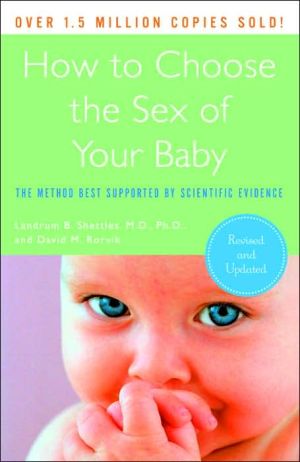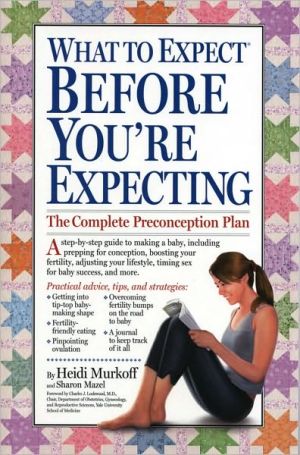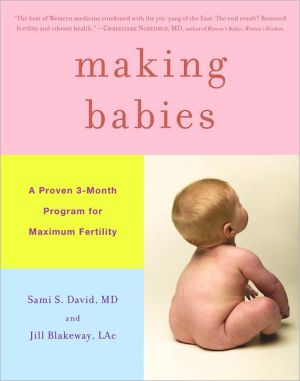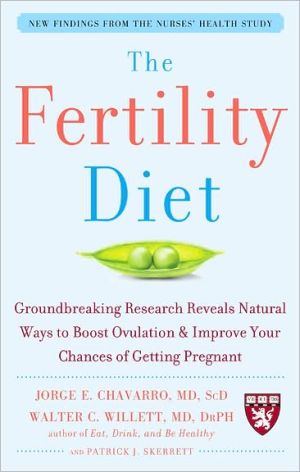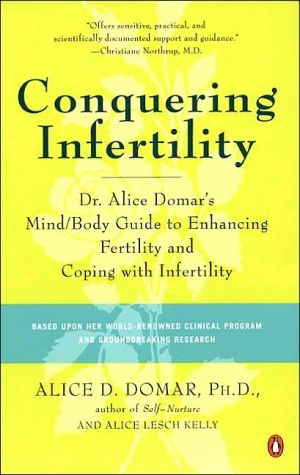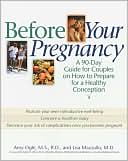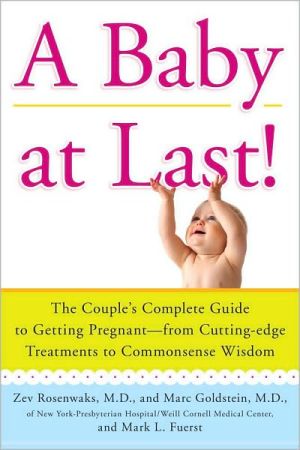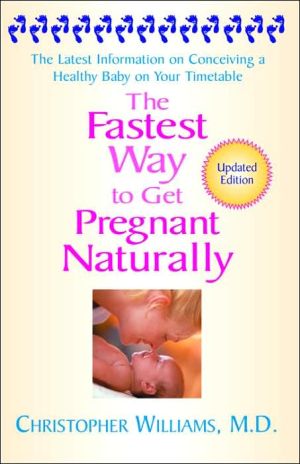How to Choose the Sex of Your Baby: The Method Best Supported by Scientific Evidence
For almost forty years, How to Choose the Sex of Your Baby has been the standard reference for couples trying to increase their chances of having the son or daughter they hope for. In this new edition of their classic book, Dr. Shettles and David Rorvik provide authoritative scientific studies and compelling anecdotal evidence demonstrating that the Shettles method continues to produce results unmatched by any other method. Dozens of testimonials confirm its ease of use and rate of success.\...
Search in google:
For almost forty years, How to Choose the Sex of Your Baby has been the standard reference for couples trying to increase their chances of having the son or daughter they hope for. In this new edition of their classic book, Dr. Shettles and David Rorvik provide authoritative scientific studies and compelling anecdotal evidence demonstrating that the Shettles method continues to produce results unmatched by any other method. Dozens of testimonials confirm its ease of use and rate of success.How to Choose the Sex of Your Baby explains the simple, at-home, noninvasive Shettles method and presents detailed steps to take to conceive a child of a specific gender. The properly applied Shettles method gives couples a 75 percent or better chance of having a child of the desired sex. Some researchers have reported success rates of up to 90 percent! Library Journal In this fourth revision, some steps of sex-selection have been refined or eliminated over the years, but the accurate determination of time of ovulation remains the basic tenet. The authors endorse the cervical mucous method for ovulation detection and consider other procedures as alternatives or additional means in achieving success. They attribute traditionalists' reticence to providing sex-selection guidelines to a concern for ethical questions of ``gendercide,'' but they argue that most parents do consider sex-selection to balance families. It is an alluring concept, judging by the popularity of previous editions. This updated and moderately priced version is highly recommended for public libraries.-- Mary Hemmings, Health Science Lib., McGill Univ., Montreal
Nearly 40 Years of Success!\ \ Forty years! We find it hard to believe ourselves. For nearly four decades now, prospective parents from Biloxi to Bombay, Chicago to Cape Town, Seattle to Shanghai have been using our method to choose the sex of their children. Millions of people throughout the world have used the Shettles method with consistent good results, making us the past, the present, and, we trust, the future number-one guide to sex selection on the planet.\ During those four decades, we have faced plenty of competition and quite a few “imitators” of our method. But as the competition has come and gone, the Shettles method has persisted, fueled primarily by satisfied word of mouth. Were it not for couples who have used our method with success and reported this to their friends and neighbors, we, too, would long since have fallen by the wayside. Failure doesn’t keep anything going for years, let alone 40 years. Only success can do that. And so, to you, our faithful readers, some of whom have used our method to attain not merely one child of the desired sex but two or more, often creating gender-balanced families in the process, we express our heartfelt thanks and appreciation.\ And to those of you completely new to our book and our method, we say Welcome. We are delighted to add you to our ever–growing “family” and trust that you, too, will add to your families the children you will cherish, whatever their genders.\ Since we last revised this book, some other sex–selection methods have come along, both low tech and high tech. We will be talking more about these later on. But, as usual, we have noted that when something “new” is announced in this field, it is often really just a restatement or a variation on components of the Shettles method.\ By the same token, findings that sometimes claim to refute the Shettles method generally fail when they are more closely scrutinized or more thoroughly followed up over longer periods of time. We will provide examples of this later on. We will also tell you about some high-tech methods of sex selection, both old and newly emerging ones, that, unlike the Shettles method, are generally opposed by bioethicists and by the majority of doctors and medical professionals, for reasons we will discuss. We are confident that most couples will continue to find our approach to sex selection the easiest, the most natural, and the most reliable, as well as the most ethical.\ This is the sixth revision of our book since it was first published in April 1970. It contains all of the latest sex–selection data. Our method has been consistently effective and consistently refined over the years to make it easier and more comfortable for all to use. Our success rate continues to be 75 percent or better for those seeking girls and 80 percent for those who seek boys. And the rate of success is even higher among those who have reported to us on our questionnaires (see later in this book) that they were "highly confident" that they had precisely pinpointed the time of ovulation—a key factor in the Shettles method.\ In the pages ahead, you’ll hear from a number of those who have tried the method—and we’ll be answering questions many of you have sent us since our last edition appeared several years ago.\ Again, congratulations for joining the sex-selection team that has been getting results in more than twenty countries for forty years. At a national meeting of the American College of Obstetricians and Gynecologists, Dr. Shettles was credited with having published “the landmark paper,” in the early 1960s, which made sex preselection a subject that could and should be taken seriously. By having made the decision to investigate and, we hope, use sex selection yourself, you have become part of a landmark effort that we believe will continue to flourish.\ Dr. Shettles' Track Record\ Though the Shettles method remains “theory” and is disputed by some, you should be aware that Dr. Shettles has a formidable record for being both ahead of his time and right. He and Dr. John Rock of Harvard were the first to fertilize human eggs in vitro, launching what is today a revolution in fertility research. But it took literally decades for other researchers to follow up on their pioneering work. In the 1960s, Dr. Shettles discovered a method of obtaining fetal cells that could be used to assess fetal health and rescue distressed pregnancies, detect defects, and so on. Other researchers said they could not duplicate his research or simply ignored it—despite its enormous implications. Finally, researchers in mainland China reported they had duplicated the work, and this was then followed up on by researchers in Indiana, who finally realized the full import of the development and credited Dr. Shettles with its discovery. Today this technique (called chorionic villi sampling) has partially supplanted the more dangerous amniocentesis as a method of monitoring fetal health—and, unlike amniocentesis, it can be used from the very earliest stages of pregnancy with minimal invasion.\ Then, in 1979, Dr. Shettles reported on another technique he had developed by which a fertilized egg could be surgically transferred directly into a woman’s fallopian tube to achieve pregnancies that could otherwise not occur, owing to various infertility problems. At first, this technique, which has come to be known as gamete intrafallopian transfer, or GIFT—and it truly is a gift to many of the infertile—also was ignored and no credit was given. But GIFT rapidly became one of the crown jewels in the armamentarium of infertility research and treatment and is today regarded as one of the most important developments in that field in the twentieth century.\ Finally, in 1991, in an editorial in the Journal of in Vitro Fertilization and Embryo Transfer, Dr. Shettles was given long-overdue credit and hailed as the father of GIFT. The editorial concluded:\ In the case of GIFT a scan of the medical literature of the past 15 years clearly shows that L. B. Shettles should be credited with the introduction of the concept of transferring gametes into the fallopian tubes as a means of achieving a pregnancy. Frederick P. Zuspan, editor of the American Journal of Obstetrics and Gynecology, in his letter to Shettles notifying him of the acceptance for publication of his landmark paper, stated the need for its publication “as soon as possible as it opens new avenues for therapy.”\ Dr. Shettles, who was once described by Omni magazine as “one of the twentieth century’s titans in the field of female infertility,” is delighted that he’s still challenging orthodoxy right into the twenty–first century.\ Can We Really Choose the Sex of Our Children?\ Yes!\ One of the reasons Dr. Shettles created the sex–selection method you are about to become familiar with is because so many of his patients at Columbia–Presbyterian Hospital in New York City asked him if there was any way he could help them tip the balance in favor of conceiving a child of a specified gender. Often these patients already had a child of one sex or more than one of the same sex and now, understandably, wanted a child of the opposite sex. Many asked the question with some hesitation, ultimately explaining to Dr. Shettles that other doctors had rebuffed them when they so inquired. Many were emboldened to ask Dr. Shettles this then-delicate question because he had been much in the news for his pioneering work in the field of female infertility. They imagined he might be sympathetic to their longings—and they were right!\ Of course, they couldn't know at the time that Dr. Shettles had been asking himself the same question, a question that he would eventually answer not only to the satisfaction of his patients and hundreds of thousands of others around the world but also to his own satisfaction as he went about creating a family of his own, consisting of three boys and three girls!\ Soon Dr. Shettles was not only able to tell couples who had not been able to conceive at all that, with techniques he helped perfect, they could indeed become parents but that it was also possible to choose the sex of one’s children with a high degree of success. The Shettles method, as it has evolved, is not 100 percent successful. It is wise to keep that in mind at all times. But the method does very significantly increase your chances—elevating them from 50 percent if you do nothing—to better than 75 percent. And, in fact, as you will see later on in this book, some researchers have reported success rates with the Shettles method reaching 90 percent!\ What's the Evidence?\ Next question: What evidence is there in support of Dr. Shettles’ sex-selection theory? The evidence is of two kinds. One kind is “anecdotal” and consists of the reports of thousands of people who say they have successfully used the method. Anecdotal evidence is not scientific evidence, but it is often very useful and suggestive nonetheless. This is especially true when a significant number of the anecdotes issue from couples who have had three, four, or more children of one sex and then, upon first trying the Shettles method, finally have a child of the opposite sex.\ The anecdotal evidence in support of the Shettles method is overwhelming. But it is not, to repeat, scientific evidence. A woman wrote a book several years ago proposing a sex-selection method that conflicted in many ways with that of Dr. Shettles. In some ways it appeared to offer opposite recommendations. (We will discuss that book in more detail later on, when we examine other sex–selection methods.) The point we wish to make here is that in the introduction to her book, this woman suggested—falsely—that we rely entirely on anecdotal evidence to support the Shettles method.\ “The only way to determine whether a sex–selection method works,” she wrote, “is, first, to enlist the cooperation of a large number of couples who state a sex preference, and, second, to note the sex outcomes of the pregnancies among couples who have meticulously followed the recommendations. . . . This is the only type of evidence that is convincing.” We agree (and only wish there had been more of this kind of evidence in that writer's book). We will demonstrate, later in this book, that the Shettles method is better supported by precisely this kind of scientific evidence than is any other method in use today. In summary, it is the one sex–selection method best supported by the available scientific data, data that have been produced by independent researchers in numerous countries throughout the world.\ It must also be pointed out that the Shettles method has persisted longer than any other sex–selection method in use today. Rather than lose followers and support, it has continued to gain them. That fact says something positive about the method. No sex–selection method can persist in the absence of “satisfied customers.” Not only laypeople but an increasing number of medical and scientific researchers have come to discern merit in Dr. Shettles’ sex-selection theories.\ Dr. Shettles began developing his techniques in the early 1960s and has continued to refine them ever since. This is the sixth and by far the most comprehensive book we have written on the subject. We are confident that this book will make it easier than ever before for couples to utilize the Shettles method and, at the same time, to learn about other methods, some of which have at least partial validity and some of which, in our view, do not.\ How It Began\ How did Dr. Shettles get involved in sex-selection research? First, he did not enter the field with the idea of making abstract scientific points; rather, he was directly motivated by the desire to help alleviate some of the disappointment many of his patients expressed over being unable to conceive a child of the sex they desired. Time and again couples came to him with the same story: they had already had two, three, or more children of the same sex and very much wanted one of the opposite sex. In some cases it was clear that these couples would “keep trying” until they achieved their goal, even though they might already have had more children than they really wanted or could afford.\ It became evident to Dr. Shettles, even many years ago, that a sex-selection method, if it could be made to work, would not only alleviate suffering among couples and within families but could also have a favorable impact on society as a whole. If couples could achieve sexually balanced families with a minimum of “tries,” then there was a good chance, Dr. Shettles reasoned, that population growth, increasingly a threat to society, could be slowed down to some extent. Most parents and prospective parents told Dr. Shettles that what they had always wanted were two children—one of each sex. If they could have one boy and one girl, they said, they would consider their families complete.\ Failure to achieve that ideal one boy/one girl balance, or at least to have children of both sexes, often resulted in psychological distress sometimes as acute, Dr. Shettles observed, as that experienced by some of his infertility patients—couples who had so far been unable to have children of either sex. As an authority in the field of infertility and human reproduction, Dr. Shettles was approached by many couples as their “court of last resort.” Many came to him with woeful tales of indifferent and insensitive doctors who, in the case of the infertile, sometimes callously argued that “there are already too many babies, anyway,” and, in the case of those with sexually imbalanced families, “you should just be happy you have children at all.” Such arguments might have some validity in an abstract or general sense. But Dr. Shettles has never regarded his patients as either abstractions or generalities. They are individuals with individual problems and needs. Their problems require, and deserve, individual solutions.\ Thus it seemed entirely appropriate to Dr. Shettles to try to apply some of the same ingenuity that he had used in solving various infertility problems to sex selection. He would try whatever seemed to work, guided by pragmatism. He did not worry about whether what he was doing fit into “accepted” or “appropriate” practice, as judged by his peers. If it was safe and effective, if it worked for his patients, then he was all for it. There is no denying that Dr. Shettles has raised a few scientific hackles in the course of his sex-selection work. There are some doctors, apparently, who think this whole field is beneath them. They refuse to acknowledge that the method works and will not investigate it themselves. Fortunately, there are more researchers who do have open minds, and, in any event, Dr. Shettles’ reward has been the satisfaction of his patients and the many others who have made use of his work.
\ Library JournalIn this fourth revision, some steps of sex-selection have been refined or eliminated over the years, but the accurate determination of time of ovulation remains the basic tenet. The authors endorse the cervical mucous method for ovulation detection and consider other procedures as alternatives or additional means in achieving success. They attribute traditionalists' reticence to providing sex-selection guidelines to a concern for ethical questions of ``gendercide,'' but they argue that most parents do consider sex-selection to balance families. It is an alluring concept, judging by the popularity of previous editions. This updated and moderately priced version is highly recommended for public libraries.-- Mary Hemmings, Health Science Lib., McGill Univ., Montreal\ \
